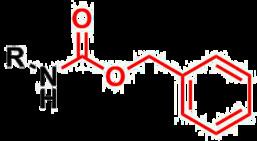 | ||
Carboxybenzyl, symbol Cbz, Cbo (old symbol), or Z (in honor of its inventor Leonidas Zervas), is a carbamate which is often used as an amine protecting group in organic synthesis. It is commonly used in peptide synthesis where the carboxybenzyl protecting group is introduced by reacting the amine functionality with benzyl chloroformate in the presence of a weak base:
Contents
- Amine protection
- Most common amine protection methods
- Most common amine deprotection methods
- References
Alternatively, as in the Curtius rearrangement, it is made by the trapping of an isocyanate with benzyl alcohol.
It is used to protect amines from electrophiles. The protected amine can be deprotected by catalytic hydrogenation or treatment with HBr, yielding a terminal carbamic acid that then readily decarboxylates to yield the free amine.
The method was first used by Max Bergmann and Leonidas Zervas in 1932 for the synthesis of peptides. The abbreviation Z is in honor of Zervas.
Amine protection
The carboxybenzyl group (Cbz) is commonly used in organic synthesis as a protecting group for amines.
